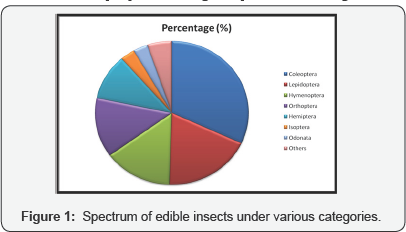Entomophagy: A New Dimension towards Food Security
Goutam Roy Chowdhury1, Sufia Zaman2, Upasana Datta2, Nabonita Pal2 and Abhijit Mitra3*
1Chancellor, Techno India University, India
2Department of Oceanography, Techno India University, India
3Department of Marine Science, University of Calcutta, India
Submission: July 18, 2017; Published: July 26, 2017
*Corresponding author: Abhijit Mitra, Department of Marine Science, University of Calcutta, 35 BC Road, Kolkata 700019, India, Tel: 09831269550; Email: abhijit_mitra@hotmail.com
How to cite this article: Goutam Roy C, Sufia Z, Upasana D, Nabonita P, Abhijit M. Entomophagy: A New Dimension towards Food Security. Organic & Medicinal Chem IJ. 2017; 3(1): 555603. DOI: 10.19080/OMCIJ.2017.03.555603
Introduction
The planet Earth is sustaining an enormous mass of human population which is exponentially exceeding the carrying capacity of the planet. It is expected, that by 2050, the world will host 9 billion populations for which there will be a demand of enormous protein bank. The overexploitation of land and ocean resources has created a big gap between the protein demand by human population and protein supply from these conventional sources. This gap can be filled up by insect protein. Edible insects have always been a part of human diet since time immemorial.
Till date most of the insect are supplied through wild collection from the forests. Very few countries have initiated research on the standardization of insect rearing system. Globally the most commonly edible insects are: beetles (coleopteran), caterpillar (Lepidoptera), bees, wasp and ants (hymenoptera). In addition to this, the species under orthoptera like grasshoppers, crickets, locusts, etc. are also consumed by human beings. Figure 1 represents the spectrum of edible insects under various categories (Figure 1). The present paper is a first order analysis of rearing the edible insect species at Techno India University (TIU) West Bengal, Salt Lake, Sector-V Campus, Kolkata-700091, and India for the purpose of using the species as food ingredients.

Insect: A Non-Conventional Nutrition Bank
Edible insects are highly nutritious and healthy food source with high fat, proteins, vitamins, fiber and mineral content. The level of biochemical ingredients in insects is a function of their life-cycle stage, the diet they consume and the habitat in which they thrive. It has been documented that certain species of insects have unsaturated omega-3 fatty acids which is comparable with that in the fish.
Many insects are often consumed entirely as a whole, but certain insects are processed into granular paste or powder form. In tropical countries, insects are consumed whole, but for grasshoppers and locusts it is essential to remove the wings and legs. Fresh insects are also processed by roasting, frying or boiling. Sometimes they are served with lime leaves to increase the taste and appetite. Many insects are consumed in granular or paste form. An easy way to obtain powder is by drying and grinding the insects.
Role of Insects in Climate Change
The planet Earth is under the appalling shadow of climate change Mitra [1], Mitra and Zaman [2], Mitra and Zaman [3] Pal et al. [4]. The rise of temperature due to emission of Green House Gases (GHGs') has become a universal phenomenon throughout the world. In this context it is important to reduce the emission of GHGs. Insects play a vital role in this process through the following ways:
a) Carbon sequestered in the green vegetation is not returned back to the nature by decomposition rather they are consumed and subsequently converted to body mass of the insects.
b) Insects produce less ammonia to the atmosphere as compared to livestock waste.
Looking Forward
The insect protein has been identified as one of the alternative source of protein and has the possibility of replacing mutton, chicken and beef in future. However, a long term research is still to be conducted in the domain of insect consumption safety involving a wide range of stake holders. The process of entomophagy has several ecosystem benefits like reduction of GHG emission, providing alternative source of nutrition as well as alternative livelihood leading to employment generation. For achieving this target, there is a need to develop technological innovation, change in consumer preferences, amendment of food related legislations, etc. Considering the huge quantum of insect biomass needed to fill-up the protein deficiency (which is presently obtained from soya beans, fish, meat etc.) automated rearing facilities, standardization of species - specific rearing technologies for insects and safety measures for insect diet are extremely essential.
The target will be achieved through Public-Private Partnership (PPP) model and close collaboration of Government, industries and researchers.
References
- Mitra A (2013) In: Sensitivity of Mangrove ecosystem to changing Climate. Springer pp. 323.
- Mitra A, Zaman S (2015) Blue carbon reservoir of the blue planet. Springer.
- Mitra A, Zaman S (2016) Basics of Marine and Estuarine Ecology. Springer.
- Pal N, Saha A, Biswas P, Zaman S, Mitra A, et al. (2016) Loss of carbon sinks with the gradual vanishing of Heritiera fomes from Iindian Sundarbans. Research Article 4. In: Environmental Coastguards- Understanding Mangrove Ecosystem and Carbon Sequestration.






























